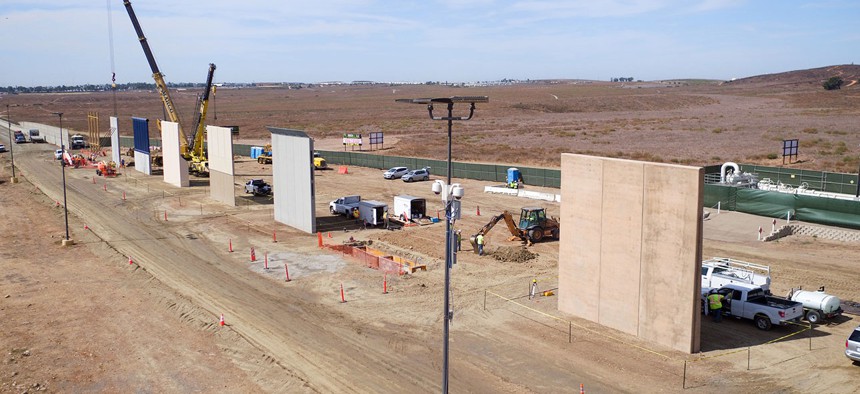
Construction crews prepare a set of border wall prototypes along the U.S. border with Mexico in October. Mani Albrecht/CBP
Could Trump Actually Use Military Funding for His Border Wall?
The president would have to overcome obstacles in Congress, and perhaps even legal challenges, to use Department of Defense resources on construction.
President Trump can’t seem to find the funds to fulfill his signature campaign pledge of building a border wall—and his Plan C could get even more complicated.
On the campaign trail, Trump insisted that Mexico would pay for the wall, a proposal that the Mexican government quickly shut down. Once in office, Trump looked to Congress to foot the bill, but lawmakers—many of whom are unconvinced there’s a need for additional construction—only allocated $1.6 billion for the wall in the $1.3 trillion spending package they passed earlier this month. The figure falls well short of the $25 billion that Trump asked for, and most of the funds are for repairing existing barriers, not mounting new ones.
Now, Trump has reportedly floated the idea of the U.S. military footing the bill—a move that would dramatically change how the government has approached border security in recent years. The Department of Defense has much deeper pockets than the Department of Homeland Security to pull from, but any attempt to use DOD funds would likely face serious obstacles in Congress and perhaps even legal challenges. Shifting some of the responsibility of securing the border from DHS, which has long had jurisdiction, to DOD would mean putting the department in a position to lead where it’s chiefly held a supporting role.
Using DOD money for the wall would likely require congressional approval. But “the bigger question is whether Congress really wants the president treating something that has historically been a law-enforcement enterprise as a defense enterprise, as a military enterprise,” said Christopher Swift, an adjunct professor of national-security studies at Georgetown University and a partner in the national-security practice at Foley & Lardner, LLP, an international law firm. News reports on Trump’s plan haven’t specified whether DOD would have full control over the wall, its construction, and patrols of the surrounding areas. But security experts I spoke with think that’s a possibility. Attempts to have the department fund the wall but not oversee it would likely result in an “administrative nightmare,” Swift said.
According to an Associated Press report published last week, Trump has raised his military-funding idea with House Speaker Paul Ryan. Pentagon spokeswoman Dana White also confirmed that Defense Secretary Jim Mattis has discussed the proposal with the president, but did not provide additional details. While Trump himself has not publicly spoken about the plan, he seems to have alluded to it on Twitter: “Because of the $700 & $716 Billion Dollars gotten to rebuild our Military, many jobs are created and our Military is again rich. Building a great Border Wall, with drugs (poison) and enemy combatants pouring into our Country, is all about National Defense. Build WALL through M!” (Two Trump advisers told The Washington Post “M” stood for military.)
DOD operating along the border isn’t unusual. It has helped DHS in the past with border-security measures, and before DHS was established in 2002, the military served a number of functions along the border over the course of U.S. history, explained Richard Kohn, a military historian and professor at the University of North Carolina, Chapel Hill.
During their respective tenures as president, George W. Bush and Barack Obama deployed National Guard troops to temporarily bolster security along the border during influxes of illegal crossings and drug trafficking. The Joint Task Force North, established in 1989 as part of former President George H.W. Bush’s counterdrug efforts along the border, was originally intended to provide support to local, state, and federal law-enforcement agencies. And the Army in particular has worked closely with Customs and Border Patrol, helping train agents and offering additional enforcement, including for reconnaissance missions. “One of the biggest benefits that we see, working with active-duty military, is the technology and expertise that the Army brings to border enforcement,” said then-Border Patrol Special Operations Supervisor Andy Adame in 2012.
DOD has even been involved in the kind of barrier construction Trump proposes. The Army Corps of Engineers, a federal agency within DOD that provides public engineering services both domestically and abroad, has assisted CBP by overseeing contractors and serving in an advisory role on construction projects. Most recently, the corps helped “assess and evaluate” the eight prototypes for Trump’s proposed wall, according to a CBP statement.
CBP “in this relationship is the owner of the mission pertaining to border security,” said retired Major General Merdith W.B. Temple, who served as the acting chief of engineers and the acting commanding general of the Army Corps of Engineers from 2011 to 2012. But the corps provides the necessary technical know-how. Back in 2006, for example, after Bush authorized double-layer fencing along the border, CBP “did not have an organic or inherent engineering capability” to handle the project on its own, Temple explained, and thus needed assistance.
But using the military for more permanent security tasks would be unprecedented, Kohn argued. “The use of the U.S. military for something other than fighting world wars is a long American tradition,” he said. “But to [do so] at this moment in time, when you have a major beefing-up of Immigration and Customs Enforcement and [the] border-security agency, and all other institutions and organizations and agencies in DHS, to use the U.S. military just for common, everyday operations is not appropriate and would be contested.”
There are legal limits on what DOD can do at the border. A 2013 Congressional Research Service report spelled out the extent to which the department can provide DHS reinforcement: While the military has “general legislative authority that allows it to provide support to federal, state, and local law enforcement agencies (LEAs) in counterdrug and counterterrorism efforts, and in combating certain border-related immigration and smuggling crimes,” other actions would require congressional authorization.
That includes having DOD take the reins entirely on the funding, construction, and monitoring of the border wall, Swift said. If Trump were to go that route, the challenge he’d face would be twofold: He would not only need congressional approval to use military funds for the wall, but he’d also need a separate authorization for DOD to administer the funds along the border.
Both steps would be tricky to pull off, if not impossible. If Trump wanted to dip into DOD funds already appropriated in the 2018 spending package, he’d need Congress’s OK, a Pentagon official told the Post. To set aside funds in next year’s budget, he would have to submit a budget amendment that would require 60 votes in the Senate—a threshold the upper chamber consistently struggles to meet on big pieces of legislation. As the Post’s sources noted, military officials, Democrats, and Republican defense hawks would likely oppose taking resources away from existing DOD projects and shifting them to the wall.
Given these potential challenges, the president could try to avoid Congress altogether and unilaterally direct DOD to fund the wall. To do so, the administration would have to find legislative language that allows the president to transfer funds for other purposes, said Saikrishna Bangalore Prakash, a law professor at the University of Virginia. “They need to read some language somewhere as appropriating money that can be used for a border wall, and it could be a combination of language that’s ordinarily thought of to be an authorization, or it could be in the appropriations bill,” Prakash said.
To that end, there are a few options the Pentagon could pursue. But the money would not amount to the president’s request of $25 billion, and its use would still likely receive pushback from Congress and be subject to legal challenges. Just Security reports that the Pentagon could use funds intended for counternarcotics operating programs; or it could exercise one of two authorities provided through DOD’s emergency military-construction funds, which would allow it to circumvent Congress’s authority over military-construction projects:
The first authority allows up to $50 million to be spent on a construction project if it is for national security and to protect the safety of U.S. troops.
The second emergency authority has no spending cap, but it is only to be used in the event of a national emergency or a declaration of war. The last time the United States declared war was in World War Two, so that’s not going to happen.
If the administration were to lean on existing legislation to justify the use of military funding, Congress could hypothetically sue (though that’s less likely with Republican control over both chambers). Lawmakers previously sued the Obama administration for allegedly misusing Affordable Care Act funds. At the time, the Obama administration wanted to give subsidies to health-insurance companies to reduce patient costs, a measure that was authorized by the ACA bill but without any specific funding from Congress.
The administration argued that it had authority under the ACA to dole out funding, and therefore didn’t require Congress’s approval to use some of it for the subsidies. “They basically reinterpreted it and came to the conclusion that they didn’t need a separate appropriation,” Prakash said. As a result, the Republican-led House sued.
Other entities could also hypothetically file suit, though construction would likely have to be under way for them to have standing. “Usually, someone has to be injured by government action before they can sue to challenge it,” Stephen Vladeck, a law professor at the University of Texas School of Law, told me in an email. “So with regard to the fund[ing] transfer, it’s hard to imagine who would have standing until and unless someone is injured by the actual expenditure of unappropriated funds—for example, a property owner along the border where the fence is built.”
It’s difficult to tell how serious the president is about using military funding for the wall. And it’s unclear whether he or his advisers would be put off by these many potential complications. But Trump does appear to be growing more agitated about the little headway he’s made on the wall more than a year into his presidency. On Wednesday, he tweeted, “Great briefing this afternoon on the start of our Southern Border WALL!” What comes after the start could depend on how badly he wants the wall built.







